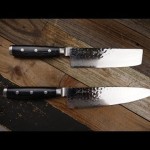When it comes to kitchen knives, there are many different types to choose from. Two of the most popular types of knives are Usuba and Nakiri knives. Both of these knives have their own unique features and benefits, so it can be difficult to decide which one is best for you. In this article, we will discuss the differences between Usuba and Nakiri knives, so you can make an informed decision about which one is right for you.
Is Nakiri or Usuba better
When it comes to Japanese kitchen knives, two of the most popular types are the Nakiri and the Usuba. Both knives are used for cutting vegetables, but they have some distinct differences that make them better suited for different tasks.
The Nakiri is a double-beveled knife with a rectangular blade. It is designed for chopping vegetables and has a flat edge that makes it easy to cut through vegetables in a single stroke. The Usuba, on the other hand, is a single-beveled knife with a thinner blade. It is designed for precision cutting and is often used for making thin slices and intricate cuts.
When it comes to deciding which knife is better, it really depends on the task at hand. If you are looking for a knife to chop vegetables quickly and easily, then the Nakiri is the better choice. However, if you need a knife for precision cutting and intricate slicing, then the Usuba is the better option.
In terms of durability, both knives are made from high-quality materials and are designed to last. The Nakiri is usually made from stainless steel, while the Usuba is usually made from carbon steel. Both knives are also designed to be easy to sharpen and maintain.
In conclusion, both the Nakiri and Usuba are excellent knives for cutting vegetables. The Nakiri is better suited for chopping vegetables, while the Usuba is better for precision cutting and intricate slicing. Both knives are also durable and easy to maintain.
What are the benefits of a Nakiri knife
A Nakiri knife is a traditional Japanese vegetable knife that is used for slicing, dicing, and chopping vegetables. It is a versatile and essential tool for any kitchen. The Nakiri knife has a straight blade that is designed to make precise, thin cuts. It is also lightweight and easy to maneuver, making it ideal for preparing vegetables quickly and efficiently.
The Nakiri knife is designed with a flat blade that is perfect for chopping vegetables. The flat blade allows for a smooth, even cut that is perfect for making thin slices of vegetables. The blade is also sharp enough to easily cut through tough vegetables like carrots and potatoes. The blade is also designed to be easy to sharpen, so it can maintain its sharpness for a long time.
The Nakiri knife is also lightweight and easy to maneuver. This makes it ideal for quickly and efficiently preparing vegetables. The lightweight design also makes it easy to use for extended periods of time without causing fatigue. The handle is also designed to be comfortable and ergonomic, making it easy to grip and control.
The Nakiri knife is also incredibly durable. It is made from high-quality stainless steel that is designed to last for many years. The blade is also designed to be rust-resistant, so it can be used in wet environments without corroding. The handle is also designed to be durable and resistant to wear and tear.
The Nakiri knife is an essential tool for any kitchen. It is versatile, lightweight, and easy to use. It is also incredibly durable and designed to last for many years. The Nakiri knife is perfect for quickly and efficiently preparing vegetables, making it an invaluable tool for any cook.
Is a santoku better than a Nakiri
When it comes to kitchen knives, there are many different types to choose from. Two of the most popular are the santoku and the nakiri. Both are Japanese-style knives, but they have different uses and features. So, which one is better?
The santoku is a versatile knife that can be used for a variety of tasks. It has a wide blade with a curved edge, which makes it ideal for slicing, dicing, and chopping. The nakiri, on the other hand, is a vegetable knife with a straight blade. It is designed specifically for cutting vegetables, and its thin blade makes it easier to make precise cuts.
When it comes to performance, the santoku is generally considered to be the better knife. Its curved edge makes it easier to use for a variety of tasks, and its wide blade gives it more power when cutting through tough ingredients. The nakiri, however, is better for cutting vegetables. Its thin blade and straight edge make it easier to make precise cuts, and it is less likely to bruise delicate vegetables.
In terms of durability, both knives are quite strong. The santoku is usually made from high-carbon steel, which is very durable and resistant to corrosion. The nakiri is usually made from stainless steel, which is also very durable and resistant to rust.
When it comes to price, the santoku is usually more expensive than the nakiri. This is because it is a more versatile knife and is made from higher-quality materials. The nakiri is usually less expensive, but it is still a good quality knife.
So, is a santoku better than a nakiri? It really depends on what you need the knife for. If you are looking for a versatile knife that can be used for a variety of tasks, then the santoku is probably the better choice. However, if you are looking for a knife specifically for cutting vegetables, then the nakiri is probably the better option.
Is a Nakiri knife worth it
A Nakiri knife is a traditional Japanese vegetable knife that is becoming increasingly popular in the Western world. It is a double-beveled knife with a straight blade that is designed for chopping, slicing, and dicing vegetables. It is a great tool for anyone who loves to cook and is looking for a versatile knife that can handle a variety of tasks. But is a Nakiri knife worth it?
The answer is yes! A Nakiri knife is an excellent choice for anyone who wants a knife that is both sharp and durable. The blade is made from high-quality steel that is designed to stay sharp for a long time. It is also lightweight and easy to maneuver, making it a great choice for those who are new to cooking. The blade is also designed to be easy to clean, so you won’t have to worry about food sticking to it.
In addition to its sharpness and durability, a Nakiri knife is also a great choice for those who want a knife that is easy to use. The blade is designed to be thin and flexible, making it easy to maneuver and slice through vegetables. It is also designed to be comfortable to hold, so you won’t have to worry about your hand getting tired while you’re using it. The handle is also designed to be ergonomic, so it won’t cause any discomfort while you’re using it.
Overall, a Nakiri knife is an excellent choice for anyone who wants a versatile and durable knife that is easy to use. It is a great tool for anyone who loves to cook and is looking for a knife that can handle a variety of tasks. So if you’re looking for a knife that is both sharp and durable, a Nakiri knife is definitely worth it.
We hope this article has helped you decide which knife is best for you. Whether you choose the Usuba or the Nakiri, we wish you the best of luck in your culinary endeavors. Goodbye and happy cooking!











